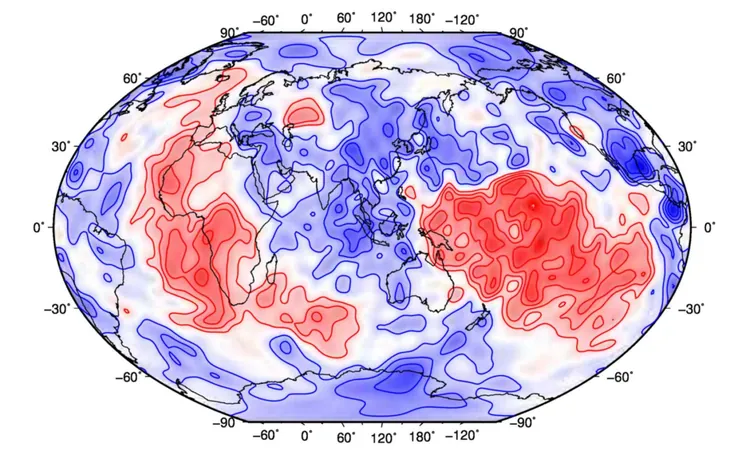
Massive 'Fortresses' Discovered Deep Beneath Earth's Surface: What You Need to Know!
2025-07-17
Author: Siti
Uncovering Earth's Hidden Giants
Geologists have made an astonishing discovery deep within the Earth—enormous structures likened to 'fortresses' located nearly 1,800 miles below the surface in the mantle. This groundbreaking find could revolutionize our understanding of Earth's geodynamics.
The Science Behind the Discovery
Recent seismic data reveals these colossal formations, known as Large Low Shear Velocity Provinces (LLSVPs), which are massive enough to rival the size of continents underneath Africa and the central Pacific. These geological giants are not only ancient but are also significantly hotter than the cooler rock surrounding them, presenting a puzzle for scientists.
The Rise of the Fortresses
Discovered through seismic tomography in the 1990s, these two substantial blobs—one beneath Africa and the other beneath the Pacific—each exceed 3,000 miles in width. Subsequent studies highlighted that the African fortress reaches about 600 miles in height, while its Pacific counterpart towers even higher.
The Earth as a Resonating Bell
Scientists liken the Earth to a colossal bell that vibrates during major earthquakes. The 1994 Bolivia quake provided invaluable insights, allowing researchers to investigate these deep fortresses through the vibrations that resonate for hours. Interestingly, the energy dynamics within these formations have shown that seismic waves encounter minimal resistance, contradicting conventional wisdom.
The Role of Grain Boundaries
A closer examination reveals that fewer grain boundaries in the minerals within these fortresses allow seismic waves to travel with less energy loss. This has led researchers to a fundamental understanding: larger grains can facilitate efficient energy transmission, which could explain the unique characteristics of these areas.
An Ancient Legacy
These giant structures date back hundreds of millions of years, likely predating even supercontinents like Pangea. Their extremely rigid nature allows them to remain stable while the surrounding mantle undergoes constant convection. This finding challenges previous assumptions of uniform flow within Earth's mantle.
Why This Discovery Matters
The thermal characteristics of these fortresses could be critical for understanding volcanic activity. For instance, they may serve as sources for mantle plumes that contribute to volcanic chains such as those in Hawaii, as well as large-scale geological events that have influenced Earth's climate and mass extinctions.
Looking Ahead: Future Research Directions
Exciting new research is on the horizon as scientists utilize advanced technologies to map these enigmatic structures further. Plans are underway for denser global seismic networks and machine-learning tools to enhance our understanding. Researchers also seek to confirm chemical compositions of these formations, linking seismic data with material science.
Conclusion: A New Era of Geoscience Awaits
This study marks a pivotal moment in Earth sciences, potentially reshaping textbooks and altering our perception of the planet's inner workings. As researchers delve deeper into these magnificent fortresses, our grasp of geological processes will continue to evolve, revealing the breathtaking complexity of our planet.



 Brasil (PT)
Brasil (PT)
 Canada (EN)
Canada (EN)
 Chile (ES)
Chile (ES)
 Česko (CS)
Česko (CS)
 대한민국 (KO)
대한민국 (KO)
 España (ES)
España (ES)
 France (FR)
France (FR)
 Hong Kong (EN)
Hong Kong (EN)
 Italia (IT)
Italia (IT)
 日本 (JA)
日本 (JA)
 Magyarország (HU)
Magyarország (HU)
 Norge (NO)
Norge (NO)
 Polska (PL)
Polska (PL)
 Schweiz (DE)
Schweiz (DE)
 Singapore (EN)
Singapore (EN)
 Sverige (SV)
Sverige (SV)
 Suomi (FI)
Suomi (FI)
 Türkiye (TR)
Türkiye (TR)
 الإمارات العربية المتحدة (AR)
الإمارات العربية المتحدة (AR)